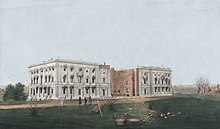13th Congress
| 13th United States Congress | |
|---|---|
|
12th ←
→ 14th
|
|

The Capitol after the August 1814 burning of Washington, D.C., by the British in the War of 1812 (painting 1814 by George Munger)
|
|
| March 4, 1813 – March 4, 1815 | |
| Senate President |
Elbridge Gerry (DR) until November 23, 1814 Vacant from November 23, 1814 |
| Senate Pres. pro tem |
William H. Crawford (DR) Joseph Bradley Varnum (DR) John Gaillard (DR) |
| House Speaker |
Henry Clay (DR) Langdon Cheves (DR) |
| Members | 36 senators 182 representatives 4 non-voting delegates |
| Senate Majority | Democratic-Republican |
| House Majority | Democratic-Republican |
| Sessions | |
|
1st: May 24, 1813 – August 2, 1813 2nd: December 6, 1813 – April 18, 1814 3rd: September 19, 1814 – March 3, 1815 |
|
The Thirteenth United States Congress was a meeting of the legislative branch of the United States federal government, consisting of the United States Senate and the United States House of Representatives. It met in Washington, D.C. from March 4, 1813, to March 4, 1815, during the fifth and sixth years of James Madison's presidency. The apportionment of seats in the House of Representatives was based on the Third Census of the United States in 1810. Both chambers had a Democratic-Republican majority. The first two sessions were held at the Capitol building while the third, convened after the Burning of Washington, took place in the First Patent Building.
The count below identifies party affiliations at the beginning of the first session of this congress. Changes resulting from subsequent replacements are shown below in the "Changes in membership" section.
Following the 1810 census, the size of the House was increased to 182 seats from 142.
This list is arranged by chamber, then by state. Senators are listed by seniority, and Representatives are listed by district.
Senators were elected by the state legislatures every two years, with one-third beginning new six-year terms with each Congress. Preceding the names in the list below are Senate class numbers, which indicate the cycle of their election. In this Congress, Class 1 meant their term ended with this Congress, requiring reelection in 1814; Class 2 meant their term began in the last Congress, requiring reelection in 1816; and Class 3 meant their term began in this Congress, requiring reelection in 1818.
All representatives were elected statewide on a general ticket.
(7 Federalists)
Both representatives were elected statewide on a general ticket.
(2 Federalists)
...
Wikipedia
